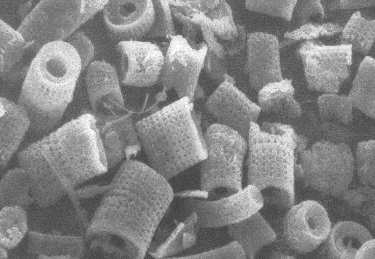DiaFil (Fresh Water
Diatoms)

You are looking at a picture of the basic raw material
from which our DE products are made. These are the skeletal
remains of the diatoms found in the product. The picture was
made by a Scanning Electronic Microscope (SEM). The SEM is a truly remarkable
instrument which enables us to visually evaluate the quality of the many types
of diatomaceous earth (DE) being mined today. There are many species of
diatoms each with its own unique physical makeup and shape; ranging from
barrel-like forms to flat discs. Before we go any farther let’s find out how
DE is scientifically defined:
“”Diatomaceous earth is a mineral product mined from
the fossilized silica shell remains of unicellular or colonial algae from the
class Bacillariaphyccae, better known as diatoms “
The diatomaceous earth pictured above shows a well
preserved, impurity-free DE product. Not
all DE’s are of the same quality many variations are found.
The wide disparity of quality that exists among various deposits of
diatomaceous earth stem primarily from the following causes:
the species of diatoms comprising the sample, the age of the deposit,
the presence of various impurities and the extent of skeletal deterioration.
With so many grades and
types of DE on the market is it possible for you to make an intelligent
choice? What steps can you take
to ensure that the DE you buy is safe for your animals, safe enough to protect
your stored grain, and last but far from least, gives you the most value for
your DE dollar? If you take the following steps you will be able to make the
right decision.
Step One:
Make sure the DE you use is AMORPHOUS DIATOMACEOUS EARTH
(ADE). In an article on DE in COMMON SENSE PEST CONTROL QUARTERLY, published
by BIRC, Volume III, Number 1, Winter 1987, the matter of safety is explored.
We quote:
“Both swimming pool grade and natural diatomaceous
earth come from the same fossil sources but they are processed differently.
The natural grades are mined, dried, ground, sled and bagged.
The pool grade is chemically treated and partially melted and
consequently contains crystalline silica which can be a respiratory hazard.
Thus, IT IS IMPERATIVE THAT ONLY NATURAL DIATOMACEOUS EARTH BE USED FOR INSECT
CONTROL. This noncrystalline silica is not a hazard as the human body
apparently can dissolve it. “
“Silicosis refers to
lung contamination and irritation by crystalline of free silica (Si02).
Crystalline describes the orientation of the Si02 molecules which occur in a
fixed pattern in contrast to the non periodic, random molecular arrangement
defined as amorphous. Exposure to free silica is an occupational hazard to
workers. “
Step Two:
Make sure the DE you use meets World Health Organization
(WHO) safety standards. WHO cautions that DE with a crystalline silica content
over three percent (3%) is dangerous for ingestion by humans or animals. Our DE has less than 1% free silica. Swimming pool DE ranges from
60% to 70% free silica and should never be used for pest control.
Step Three:
Order from
Grain Storage D10 DE
$8.00 per 1# bag
Fossil Shell Flour (Animal Feed)
$8.00 per 1# bag
About | Pricing | Household | Storage | Pets | Gardening